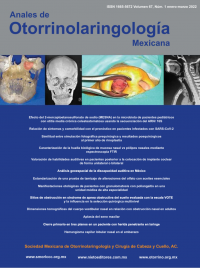
Similarity between pre-surgical photographic simulation and post-surgical results in the first year of rhinoplasty.
An Orl Mex. 2022; 67 (1): 23-31. https://doi.org/10.24245/aorl.v67i1.7355
Renato Bruno Mondani,1 José Antonio Talayero-Petra,2 Miguel Alfredo García De la Cruz,3 Nicole Almanza-Mackintoy4
1 Residente de cuarto año de Otorrinolaringología.
2 Jefe de Servicio de la División de Otorrinolaringología.
3 Medico adscrito de la División de Otorrinolaringología.
4 Médico pasante de servicio social en Otorrinolaringología.
Hospital General Dr. Manuel Gea González, Ciudad de México, México.
Resumen
OBJETIVO: Determinar la similitud entre la simulación fotográfica prequirúrgica y el resultado de rinoseptoplastia con técnica endonasal un año después de la operación.
MATERIALES Y MÉTODOS: Estudio observacional, prospectivo, analítico, transversal, en el que se analizó el archivo fotográfico de 47 pacientes operados de rinoseptoplastia con técnica endonasal.
RESULTADOS: El ángulo nasolabial fue ligeramente menor (103.05 ± 8.28) en comparación con las mediciones posquirúrgicas (103.54 ± 11.40); no obstante, no se observaron diferencias estadísticamente significativas entre estos datos. En lo que respecta al ángulo nasofrontal, se reportaron mediciones menores en el grupo posquirúrgico (133.36 ± 4.83) vs las que conformaron los registros de las simulaciones (136.83 ± 3.87). Al comparar las simulaciones con los resultados posoperatorios del índice de proyección de Goode se identificó un registro ligeramente mayor al proyectado durante las simulaciones.
CONCLUSIONES: La técnica endonasal mediante un abordaje tipo delivery, con la colocación de un poste intercrural y un injerto tipo escudo, permite lograr a largo plazo mediciones cuantitativas duraderas y consistentes al compararse con el simulador preoperatorio.
PALABRAS CLAVE: Rinoplastia; estudio transversal.
Abstract
OBJECTIVE: To determine the similarity between the pre-surgical photographic simulation with the result of rhinoplasty with endonasal technique one year after the operation.
MATERIALS AND METHODS: An observational, prospective, analytical, cross-sectional study was carried out, where the photographic files of 47 patients operated of rhinoplasty with endonasal technique were analyzed.
RESULTS: The nasolabial angle was slightly lower (103.05 ± 8.28) compared to the postsurgical measurements (103.54 ± 11.40); however, no statistically significant differences were observed between these data. Regarding the nasofrontal angle, lower measurements were reported in the postoperative group (133.36 ± 4.83) vs those that made up the simulation records (136.83 ± 3.87). When comparing the simulations with the postoperative results of the Goode projection index (Gp), a record slightly higher than that projected during the simulations was identified.
CONCLUSIONS: The endonasal technique using a delivery-type approach, with the placement of an intercrural graft and a shield-type graft, allows long-term lasting quantitative measurements to be achieved when compared to the preoperative simulator.
KEYWORDS: Rhinoplasty; Cross-sectional study.
Recibido: 2 de enero 2022
Aceptado: 25 de enero 2022
Este artículo debe citarse como: Mondani RB, Talayero-Petra JA, García-De la Cruz MA, Almanza-Mackintoy N. Similitud entre simulación fotográfica prequirúrgica y resultados posquirúrgicos al primer año de rinoplastia. An Orl Mex 2022; 67 (1): 23-31.

